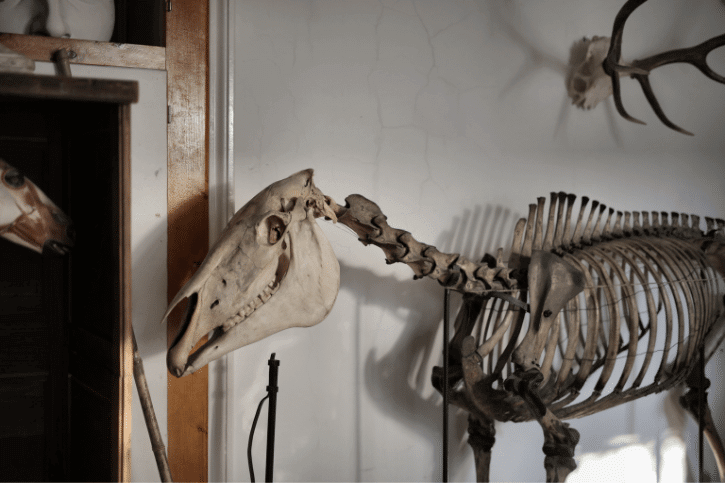How Many Bones Does A Horse Have?
My horse recently had a minor injury, and the vet had to come round and take a look at his leg, he had gotten it caught on a root while we were walking, and had very nearly fallen over, except that he managed to keep calm and not trip.
He did get it stuck pretty good, though, and I noticed he wasn’t putting as much weight onto that foot, so I called the vet.
The vet checked if anything was broken, and made a comment to me about the horse skeleton which really surprised me; how many bones they have!
So, how many bones does a horse have?
A fully mature horse has 205 bones in its body. This is only one fewer than mature humans, who have 206. So, a horse’s skeleton, though it might not look it, is actually very similar to our own. Typically, younger horses also have the full amount, since foals do a lot of developing in the womb.
Horses have a pretty constant number of bones throughout their lives, then, but this is really the main way their skeletons differ from ours.
They do less developing once they’ve been born, and so usually have a fully formed skeleton by this time.
Let’s look at it in a bit more detail.
How many bones total does a horse have?
In total, a typical horse will have 205 bones.
This includes individual vertebrae in the spine, and all of the small bones that make up smaller joints.
For example, many of our smaller bones are in our fingers and toes, and the joints in hands and feet.
Horses, obviously, have no fingers or toes but simply a single hoof.
The bones are much simpler, since they don’t need to be able to grip.
Overall, though, the skeletons of many mammals almost look like they’ve been simply stretched and moulded to fit a different frame, and that is certainly the case when you look at us compared with horses.
Our bodies have 206 bones, horses have 205, so the basic structure is essentially the same.
The main difference is that human babies have a lot more bones when they are born; usually around 300.
As the baby develops after birth, these bones begin to fuse and form full bones, reducing the total number.
This is not the case with horses, at least not post-natal.
Horses do most of their development in the womb, and their skeleton is pretty much fully formed by the time they’re born.
Do horses have more bones than humans?
So, if you’ve been following, the answer is no, they don’t!
Horses have essentially the same number of bones as humans, but they simply have very different distributions of weight.
Our skeletons are very particular to us, walking upright on two legs and using our hands and backs to lift things.
Horses have the same number of bones, but much thicker leg bones and an enormous pelvic bone.
Their necks are longer and made up of more vertebrae, as is their spine on the whole.
The pelvic limb typically contains around 19 bones, although in some individuals it may be more or less.
Horses do have great deal of variation in size, which can affect their skeleton.
So, the composition, arrangement and structure are very different, but the essential elements are really all the same.
Horses have four extremities supported by a long backbone, and their skeleton protects their vital organs, provides the framework for the body, and supports softer parts of tissue.
But they don’t have more bones than we do—in fact, they typically have one fewer!
What are the three largest bones in a horse?
You may not be surprised to learn that a horse’s largest bones are in its pelvic area.
The single, largest bone in a horse’s body is its femur; it forms a ball-and-socket joint at the pelvis to make the hip joint, and it meets the tibia and patella at the stifle joint.
The pelvis itself is the largest flat bone.
The pelvis connects to the femur, which is another large bone in the body.
The back hip joints are certainly the largest, sturdiest and strongest, since that’s how horses propel their massive bulk at such high speeds.
Naturally, their skulls are very large.
As I said, the pelvis is the largest flat bone, whereas the femur is the largest long bone.
The scapula, finally, is another one of the largest bones in the horse’s body, where the base of the neck meets the ribcage.
The largest bones, then, are the femur, the pelvis and the scapula.
Horses have large skeletons, but the number of bones they have is pretty reasonable comparatively speaking.
Their skeletons do the same jobs that our own do, just on a bigger scale.
Their bones are distributed slightly differently to account for the fact that they walk on all fours and carry many times the weight that a human skeleton would, but the principle is just the same and horses have 205 bones like us.
